文、攝影/蔡芳玲
100多年的啟明堂,光顯儒門聖地,威照東南隅,佛光遍照蓮池潭,泮水荷香傳送祝福,龜山與半屏山相望環繞一氣軒昂,春秋御閣擁護環繞,青龍白虎栩栩如生,儒、道、釋三教合一之儒宗神教各展威儀。
For more than 100 years, Chi Ming Hall has been a sacred place for Confucianism and shines with majesty in the southeast corner. The light of Buddha shines all over the lotus pond, and the fragrance of lotus conveys blessings. Turtle Mountain and Banping Mountain face each other and surround it with a majestic atmosphere. The Spring and Autumn Imperial Pavilion surrounds it, and the green dragon and white tiger are lifelike, the three religions of Confucianism, Taoism, and Buddhism were united into one, Confucianism and theology, each showing its majesty.
供奉簡介與歷史
Introduction and history of worship
光緒二十五年(1899)立廟「明德堂」,奉祀「五公菩薩」,光緒二十九年(1903)將「明德堂」更改為「啟明堂」,奉祀文聖 至聖先師孔夫子暨武聖 關聖帝君為主神。
In the 25th year of Guangxu (1899), the temple "Mingde Hall" was built to enshrine the "Five Lord Bodhisattva". In the 29th year of Guangxu (1903), the "Mingde Hall" was changed to "Chi Ming Hall" to enshrine the most holy saint of literature and art. The main god is Master Confucius、Yue Fei and Zheng Chenggong.
堂內供奉關聖帝君、孔夫子、岳武穆王與延平郡王於正殿;一樓為禮堂,二樓為社區讀書中心,三樓為三官殿,供養天、地、水三官,合稱為「三官大帝」;四樓為凌霄寶殿,供奉玉皇大帝。
本堂為儒宗神教之道場聖帝,並以興鸞濟世,勸化眾生,移風易俗,力挽頹風為使命。
The hall is dedicated to Emperor Guan Yu、Confucius、Yue Fei and Zheng Chenggong. in the main hall; the first floor is the auditorium, the second floor is the community reading center, and the third floor is the Three Official Hall, which is dedicated to the three officials of heaven, earth and water. It is the "Three Official Emperor"; the fourth floor is the Lingxiao Hall, dedicated to the Jade Emperor.
This Hall is the holy emperor of the Taoist temple for the Confucianism spirit, and its mission is to revive the world, persuade all living beings, change customs, and try to reverse the decline.
築建春秋二閣
Building the Spring and Autumn Pavilion
文聖做春秋,貶惡褒善,亂臣賊子懼;武聖讀春秋,篤行大道,三綱五常全;築春秋二閣,發揚春秋大義精神,民國四十年(1951)開工,四十二年竣工。為建築界大震撼,躍居全台八景。
“The civil servants wrote the Spring and Autumn Annals, denouncing the evil and praising the good, and feared the rebellious ministers and traitors; the military officers read the Spring and Autumn Annals, followed the rules” They built the Spring and Autumn Pavilion to carry forward the righteous spirit of the Spring and Autumn Annals. Construction started in the 40th year of the Republic of China (1951) and was completed in the 42nd year of the Republic of China. It shocked the architectural world and ranked among the top eight scenic spots in Taiwan.
民國四十年時,適值光復初期,民風純樸,建築業保守,啟明堂先賢秉持宗教信仰,遵循 神真指示,將高2、3丈之木麻黃,去皮削節,再整株打入蓮潭土壤內,再以水泥敷塗做為基樁,以人工交相攪拌混泥土鋪設,用土法建造,搭建竹架橋,一層層挑搬紅磚,溪沙、小石、水泥等建材逐堦灌砌而成,共三層外加一小樓,樓閣間築有斗拱、花籃、插角、金箔彩繪、畫棟雕樑,屬八角型架構,工程之浩瀚與偉大,可想而知。
In the 40th year of the Republic of China, at the beginning of the restoration of China, the folk customs were simple and the construction industry was conservative. The sages of Chi Ming Hall adhered to their religious beliefs and followed the instructions of God. They peeled and cut off the sections of casuarinas that were 2 to 3 feet high, and then planted the whole plant into a lotus. In the soil of the pond, cement is applied as the foundation pile, and the concrete is manually mixed and laid. It is built using earth methods. A bamboo bridge is built. Red bricks are lifted layer by layer, and building materials such as creek sand, pebbles, and cement are laid layer by layer. It is made of poured masonry, with a total of three floors and a small loft. There are brackets, flower baskets, gussets, gold foil paintings, painted pillars and carved beams between the pavilions. It is an octagonal structure. One can imagine the vastness and greatness of the project.
春秋閣之美,儼然與宮殿相似,古色古香,屹立蓮潭中,天光水色,清風徐來,水波不興,宛如人間仙境,不禁發思古之幽情。
The beauty of the Spring and Autumn Pavilion is similar to that of a palace. It stands in the lotus pond with an antique look. The sky is bright and the water is bright, the breeze is blowing, and the water is calm. It is like a fairyland on earth. We can't help but think about the tranquility of the ancient times.
興建五里亭、觀音大士騎龍聖像
Construction of the Five Mile Pavilion and the statue of Guanyin riding a dragon
民國六十六年(1976)興建五里亭,作為諸聖仙佛聖駕蒞臨,送迎之儀站,並建九曲橋,銜接春秋二閣延伸至五里亭,於六十七年大功告成。
民國六十八年為慈悲救世,普渡眾生,塑觀音大士騎龍聖像於春秋閣之間,翌年三月動工,歷時二載餘,於民國七十一年竣工。
In the 66th year of the Republic of China (1976), the Wuli Pavilion was built as a ceremonial station for the arrival of saints, immortals, Buddhas and saints. A Bridge of Nine Turnings was also built to connect the Spring and Autumn Pavilions and extend to the Wuli Pavilion. It was completed in 1977.
In 1978, in order to save the world and save all living beings, a statue of Guanyin riding a dragon was erected between the Spring and Autumn Pavilion. Construction started in March of the following year, took more than two years, and was completed in 1982.
啟明堂行政組織分堂政、社政、署政三大部門
The administrative organization of Chi Ming Hall is divided into three departments: hall administration, social affairs, and department administration
堂政:財物及一切行政事務,由堂主曾坤泰先生職掌
社政:救濟、社會服務,由社長蔡松峻先生職掌
署政:鸞務祭典,由文署曾宏一先生職掌
總幹事:協助各政處理一切事務,由洪俊義先生職掌
- Hall Administration: Property and all administrative affairs are in charge of the hall master, Mr. Zeng Kuntai
- Social administration: relief and social services, headed by President Mr. Tsai Songjun
- Cultural Administration: Luanwu Festival, headed by Mr. Zeng Hongyi
- Director-General: Assisting various governments in handling all affairs, Mr. Hong Junyi is in charge
扶鸞文化
Fuluan Culture
扶鸞為啟明堂特色文化,傳承自儒教特殊文化。鸞手透過扶鸞儀式,代天宣化,教化人心,因神不能說話,透過鸞筆,寫出鸞文來醒世。
Fuluan is the characteristic culture of Chi Ming Hall, inherited from the special culture of Confucianism. Through the Fuluan Ceremony, the Luan Hand proclaims enlightenment on behalf of heaven and educates people's hearts. Because God cannot speak, he writes God’s reminding through the Luan pen to awaken the world.
鸞手的養成,於鸞堂訓練鸞手時,徵詢有意願者,基本上須內心純正、身家清白方能參加,擇日開訓、普練。開練前先宣誓,訓練完成後,要心誠為堂效勞。普練時間為每週一、四晚上八點至九點。其他時間自己找時間在家自修、研讀聖書。三年普練,經教鸞童子認可後,在本堂靜房閉關三天,出關後才能成為真正鸞手。
For the development of Luan Hands, when training Luan Hands in the Luan Hall, those who are willing to do it, must basically be pure in heart and have a clean financial background to participate. A day will be chosen to start the training and practice. Before the training begins, take an oath that after the training is completed, you must serve the hall wholeheartedly. General training time is every Monday and Thursday from 8pm to 9pm. At other times, they have to find time to study at home and study holy books. After three years of general training, and after being approved by the Jiaoluan boy, he will be in seclusion in the quiet room of the hall for three days. Only after he is released from seclusion, he can be a real Luan practitioner.
目前鸞台任職正主席為 海公,多由城隍廟城隍爺擔綱,副主席為 吳公,由元帝廟玄天上帝擔綱,協理副主席 杜聖母,為慈德宮媽祖擔綱。另一傳說正主席海瑞乃是明朝清官。
At present, the chairman of Luantai is Haigong, who is usually held by the God of Chenghuang Temple. The vice-chairman is Wu Gong, who is held by Xuantian God of Yuandi Temple. The associate vice-chairman is held by Mazu of Cide Palace. Another legend says that the chairman, Hai Rui, was an upright official of the Ming Dynasty.
承辦鸞手多已高齡,僅存三位,如今二位往生,只剩黃文德先生擔綱。
Most of the phoenix operators are very old, and only three are left. Now two of them have passed away, and only Mr. Huang Wende is left in charge.
鸞筆是桃枝柳樹,取Y型桃枝,有避邪祈福之意。雕塑鳥頭與兩翅,在頭部插入柳枝當嘴,代表鸞鳥。扶鸞時,由正生右手,副生左手,共執鸞筆,代替鸞鳥在鸞盤上寫出文字,由唱生唱出,錄生筆錄,共同完成文章,即是鸞文。
Luanbi is a peach willow tree with Y-shaped peach branches, which means to ward off evil and pray for blessings. The bird's head and wings are sculpted, and a willow branch is inserted into the head to serve as a beak, representing the Luan bird. When Fu Luan is used, the right hand of the Zhengsheng and the left hand of the Deputy student jointly hold the Luan pen and write words on the Luan plate instead of the Luan bird. The singing student sings and records the notes, and together they complete the article, which is the Luan script.
關於鸞鳥傳說
About the legend of the Luan bird
一、鸞是種神鳥,狀似鳳凰。是東方木工老祖將一炁,化成在「西王母瑤池金母」身邊的侍者,喜愛說話、做事熱心,金母命他下凡救人,因洩漏天機,而被木工收回,削去嘴巴,從此不能說話。
Luan is a sacred bird that looks like a phoenix. It was the ancestor of the Oriental carpentry who turned Luan into a waiter beside the "Golden Mother of the West Queen Yaochi". Luan loved to talk and was enthusiastic about work. The Golden Mother ordered Luan to go down to earth to save people. However, because Luan leaked the secret of heaven, Luan was taken back by the carpenter and his mouth was cut off. From then on, Luan could not say.
二、孔子周遊列國時,受困於陳、蔡兩國,當時孔子在沙地靜坐,看見一隻靈鳥,用嘴在沙地啄字,孔聖說那是神諭,演變成今日扶鸞。
When Confucius traveled around the world, he was trapped in Chen and Cai. At that time, Confucius was sitting in meditation on the sand and saw a spiritual bird Luan pecking words on the sand with its beak. Confucius said that it was an oracle, which evolved into today's Fuluan(holding the Luan) .
啟明堂軼事之一
One of the anecdotes of Chi Ming Hall
曾宏一文署提及當初參與啟明堂事宜,源自光復時期,政府財政困難,發行儲蓄劵,強迫推銷,當時各家生活不好,曾宏一父親擔任鄰長,接這差事,對政府這強迫之事,說些不滿的話。
Zeng Hongyi mentioned that his initial involvement in the Chi Ming Hall stemmed from the financial difficulties of the government during the Restoration period. They issued to force to sell coupons. At that time, the life of each family was not good. Zeng Hongyi's father served as the neighborhood chief and took over this errand. He was responsible for the government's forced sales and said something dissatisfied about it.
當時啟明堂副主席在鸞堂上降筆給他父親,勸他少開口,父親不明究理,到廟擲筊請示,才知是儲蓄劵事,他就親自到堂參觀扶鸞情形,見鸞手竟寫出超其能力之文,從此加入堂為堂生。
At that time, the vice chairman of Chi Ming Hall wrote some advice to his father on the Luan Hall to speak less. His father didn't understand the reason, so he went to the temple to throw a chopper to ask for instructions, and found out that it was about the selling coupons. He went to the hall in person to see Fuluan's situation and saw Luan's hand. He actually wrote the advice beyond his ability, later on, he joined the hall as a disciple from then on.
民國73年初,曾宏一父親過世,年底的一個晚上,闔家吃飯,啟明堂打電話到曾宏一家,告知其父蒞堂降鸞,曾宏一覺好奇,來堂了解,到堂時,被叫到鸞台,鸞台上竟能寫出外人不知的家中困事,讓曾宏一深信是其父親蒞堂降鸞,父親並囑咐子女盡量來堂修身,從此兄姐弟尊父遺願,陸續來堂,成為啟明堂堂生。
In the early 1973 of the Republic of China, Zeng Hongyi's father passed away. One night at the end of the year, the family was having dinner. Chi Ming Hall called Zeng Hongyi's family and told him that his father was coming to the hall to inform him. Zeng Hongyi was curious and came to the hall. When he arrived, he was called to come to the Luan Tai, Zeng Hongyi was convinced that it was his father who came to the hall to sue Luan. His father also asked his children to come to the hall as much as possible to cultivate themselves. From then on, his brothers and sisters respected their father's last wish and came to the hall one after another. Become a disciple of Chi Ming Hall.
啟明堂扶鸞軼事之二
Anecdotes of Fuluan in Qimingtang Part 2
民國63年,奉保生大帝意旨,興建慈濟宮龍虎塔,於蓮池潭畔! 以進龍口、出虎口為意象,宣教化育人心。當年扶鸞,指出尋找建築師的方向,受旨的專人依指示方向尋找,找到鄭光燦建築師,回到宮中,請示神明確認。
In 1974, following the decree of Emperor Baosheng, the Dragon and Tiger Pagoda of Tzu Chi Temple was built on the bank of the Lotus Pond! With the image of entering the dragon's mouth and exiting the tiger's mouth, it was used to educate people. At that time, Fuluan pointed out the direction to find the architect. The designated person searched in the direction and found the architect Zheng Guangcan. He returned to the Hall and asked the gods for confirmation.
巧合的是,民國65年,啟明堂依神明指示,將原有老式平房拆掉,重建啟明堂。亦扶鸞依神明指示之方向找建築師,竟然也找到同一位建築師。
Coincidentally, in1976, Chi Ming Hall followed the instructions of the gods and demolished the original old-fashioned bungalow and rebuilt Chi Ming Hall. Fuluan followed the direction indicated by the gods to find an architect, and unexpectedly found the same architect.
四十歲的鄭建築師,沒有任何中式建築經驗,竟在神奇的神明護佑下,靈感充盈,運用個人結構專長,學習中式建築,方能規劃啟明堂雄偉的中式建築。
Forty-year-old Architect Zheng had no experience in Chinese-style architecture. However, under the protection of the magical gods, he was full of inspiration. He used his personal structural expertise to learn Chinese-style architecture and was able to plan the majestic Chinese-style building of Chi Ming Hall.
是怎樣的建築師,受到神明的欽點?
What kind of architect is appointed by the gods?
鄭光燦建築師民國20年出生旗津,高中考上高雄工業職業學校建築科。每天從旗津搭船步行至高雄工業學校。鍛鍊自我對話與思考,想法正向,規律不抱怨的勤懇學習,深刻將老師的授課內容融會貫通。一畢業就順利考取建築師資格。當他受領神旨執行規劃時,不退縮,用心將個人所學發揮。且將建築規畫設計費捐獻給廟方。自此之後,受神明庇佑,事業發展順風順水。
Architect Zheng Guangcan was born in Cijin in 1931. He was admitted to Kaohsiung Industrial Vocational School for Architecture in high school. Take a boat from Cijin to Kaohsiung Industrial School every day. Practice self-talk and thinking, have positive thoughts, study diligently without complaining, and deeply integrate the teacher's teaching content. As soon as I graduated, I successfully passed the qualification as an architect. When he receives God's will and implements the plan, he does not shrink back and puts his personal knowledge into full play. And the architectural planning and design fees will be donated to the temple. Since then, with the blessing of God, his career has developed smoothly.
民國83年二月,因腦溢血急診入院,醫生預估四天可活。當時,長子親至啟明堂誦經茹素祈福 ! 鄭建築師最後竟在一年半後才往生。執筊找到的長眠之地,竟也在關帝廟附近! 畢生所學,得上天認可,奉獻專長,與神同行。成佳話!
In February 1983, he was admitted to the emergency hospital due to cerebral hemorrhage. Doctors estimated that he would live in four days. At that time, the eldest son personally went to Chi Ming Hall to chant sutras, adopt a vegetarian diet, and pray for blessings! Architect Zheng finally passed away a year and a half later. The resting place that Zheng Guangcan found was actually near the Guandi Temple! What he learned throughout his life was recognized by God, he dedicated his expertise and walked with God, which becomes a good story!
八佾舞文化
Eight Yi dance culture
曾宏一文署分享當初舊孔廟位於舊城國小內(崇聖祠),孔廟祭典,由啟明堂擔任聖樂。新孔廟蓋好後,遷出舊城國小,新孔廟占地較大,也開始加入八佾舞,佾舞源於中國周朝,孔子崇尚周禮,提倡禮樂制度施行,以八佾舞紀念孔子,更有其深遠意義。
Zeng Hongyi from the Cultural Affairs Bureau shared that the old Confucius Temple was located in the Old City Elementary School (Chongsheng Temple), and Chi Ming Hall served as the sacred music for Confucius Temple ceremonies. After the new Confucius Temple was built, the old Confucius Temple was moved out of school. The new Confucius Temple occupies a larger area and began to incorporate the Eight Yi Dance. The Eight Yi Dance originated from the Zhou Dynasty in China. Confucius advocated Zhou rites and advocated the implementation of the ritual and music system. The Eight Yi Dance Commemorating Confucius has even more profound significance.
早期高雄沒有孔廟,只剩崇聖祠,祭孔都在崇聖祠舉行,由啟明堂負責聖樂,新孔廟完成後,市長想要有一個像樣的祭孔儀式,就由舊城國小負責八佾舞,由莊本立教授提供祭孔舞譜,由舊城國小擔任舞生至今。
In the early days, there was no Confucius Temple in Kaohsiung, only the Chongsheng Temple. Confucius memorial services were held at the Chongsheng Temple, and Chi Ming Hall was responsible for the sacred music. After the completion of the new Confucius Temple, the mayor wanted to have a decent ceremony to worship Confucius, so the old city elementary school Responsible for the Eight-Year Dance, Professor Zhuang Benli provided the dance score for Confucius. The students of Jiucheng Elementary School were in charge of the dancing ever since.
啟明堂地址
左營區蓮潭路36號, Kaohsiung, Taiwan
07 581 6216
Chi Ming Hall address
No. 36, Liantan Road, Zuoying District, Kaohsiung, Taiwan
07 581 6216
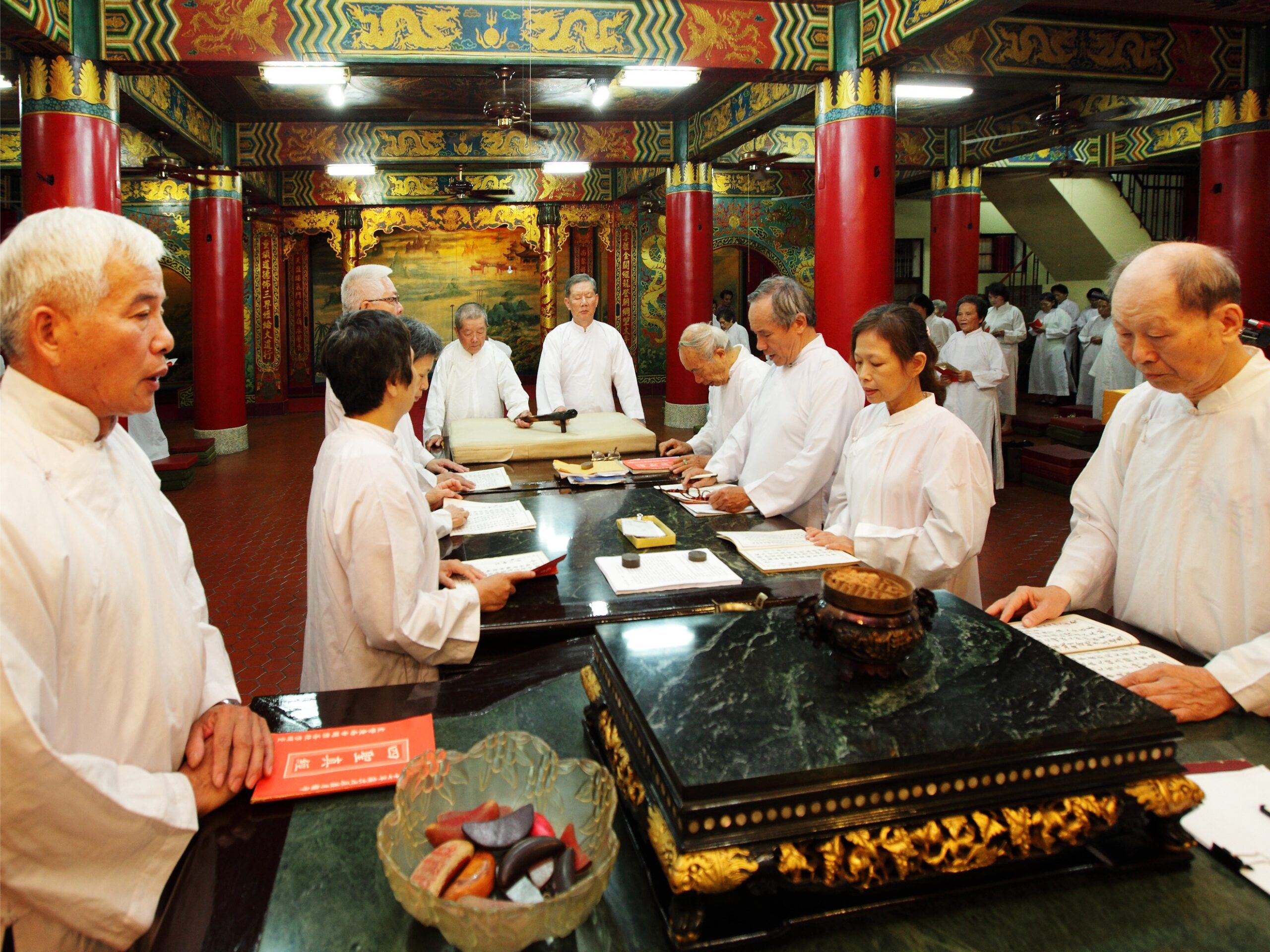
扶鸞儀式
Fuluan Ceremony
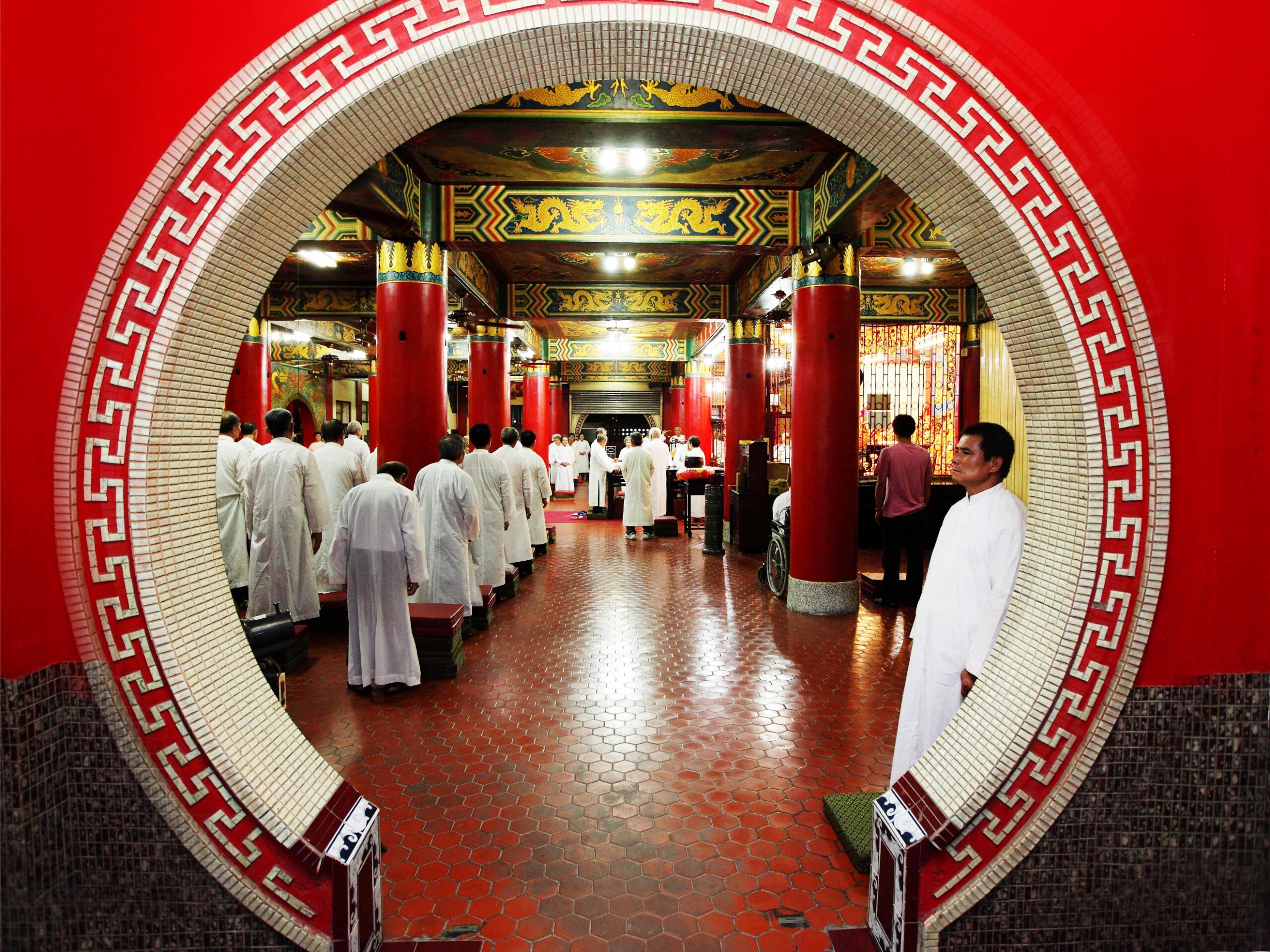
啟明堂扶鸞
Fuluan in Chi Ming Hall
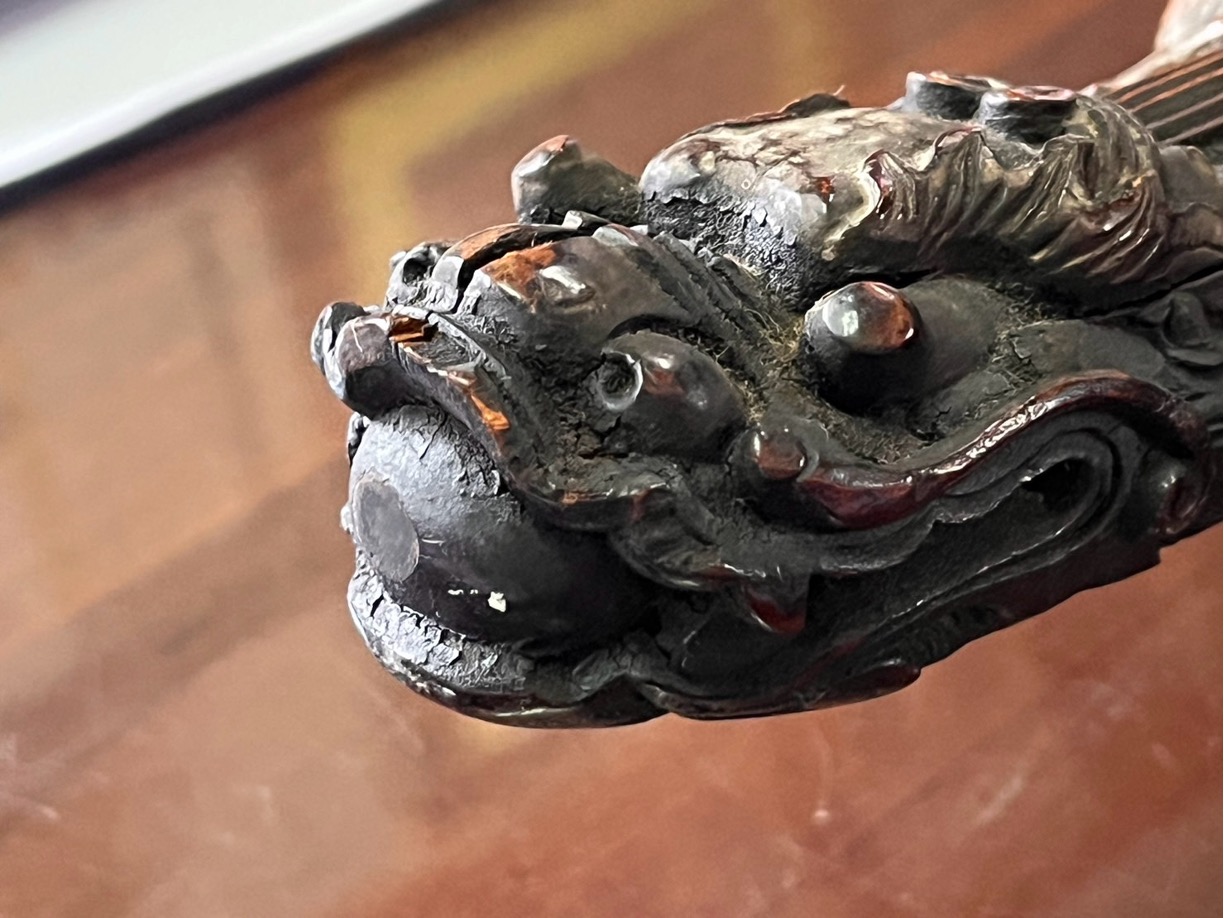
鸞筆桃枝龍頭鳥身
Special pen used for Fuluan
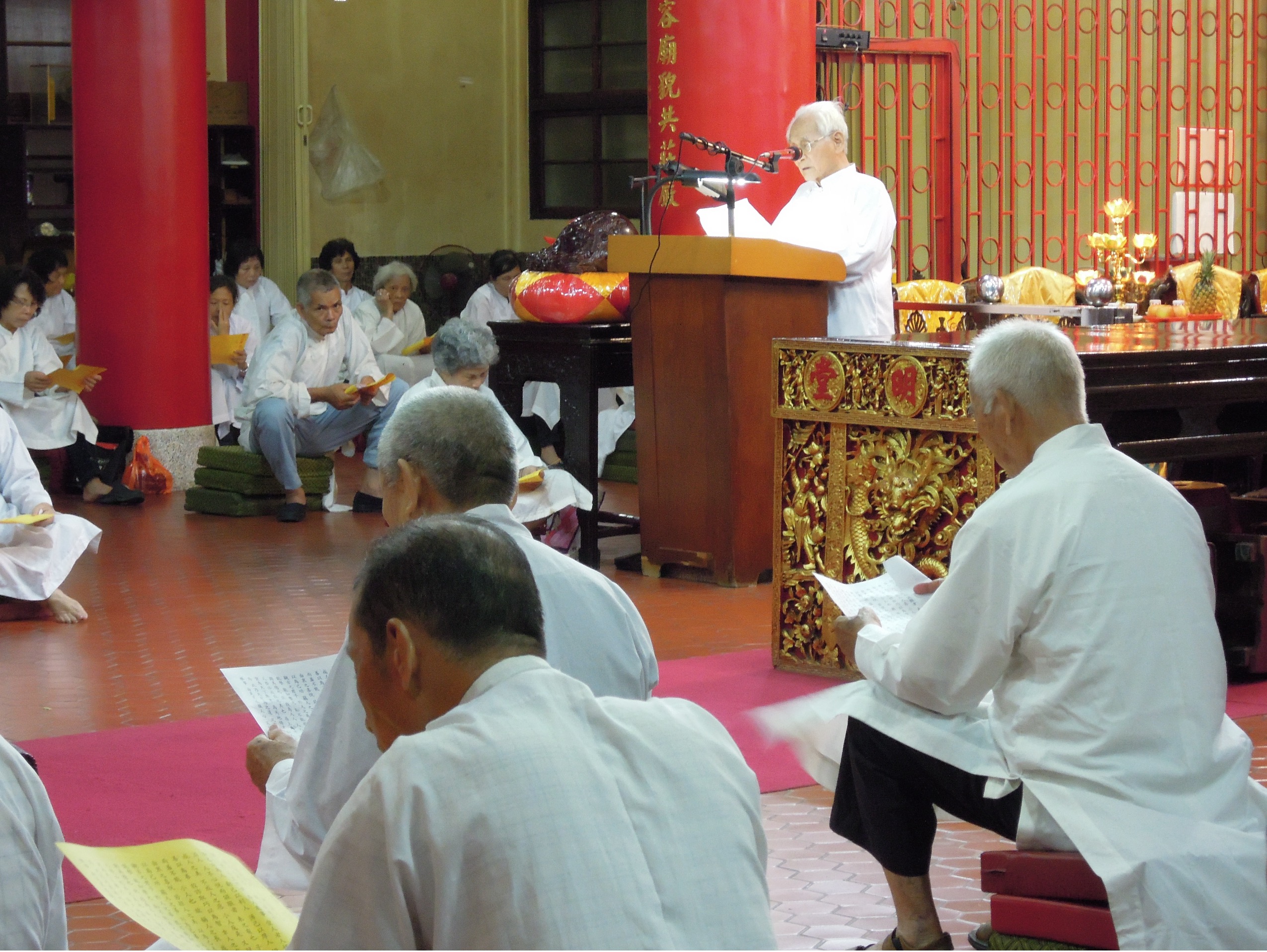
扶鸞誦經儀式
Fuluan Chant Sutras
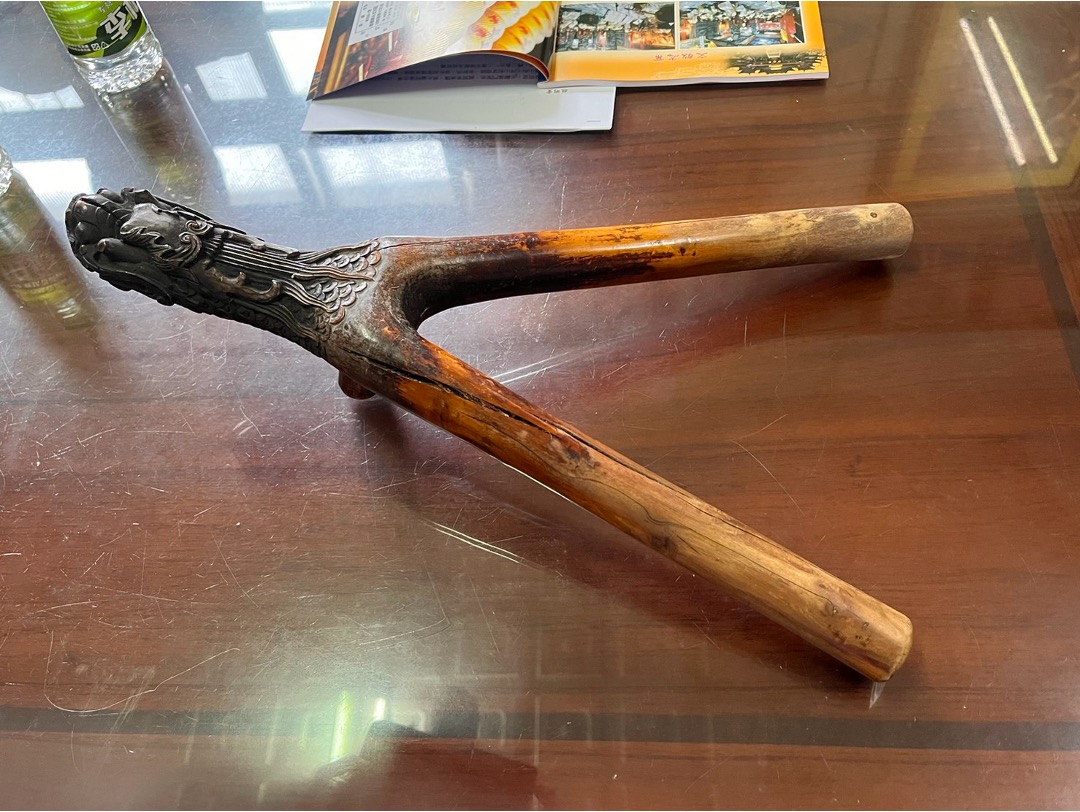
鸞筆桃枝龍頭鳥身雙翼 消災祈福
Special pen used for Fuluan in order to seek spiritual blessings
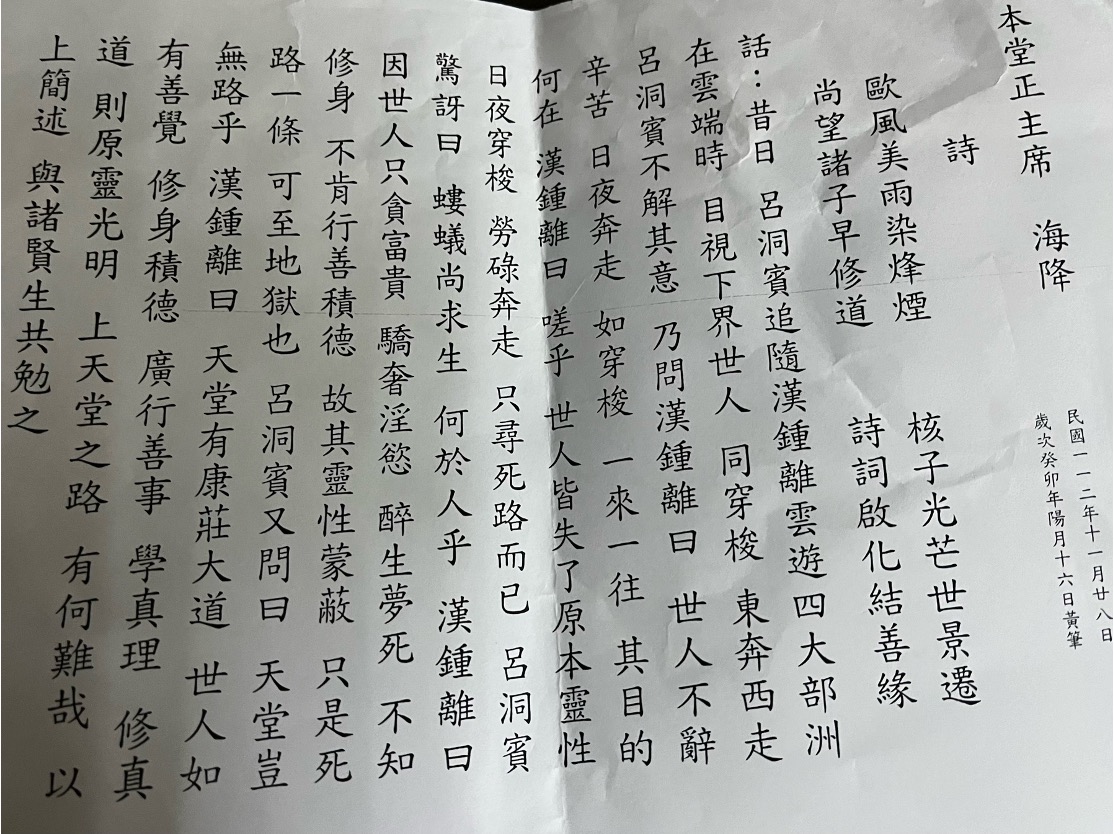
宣化詩
Special poems used for Fuluan
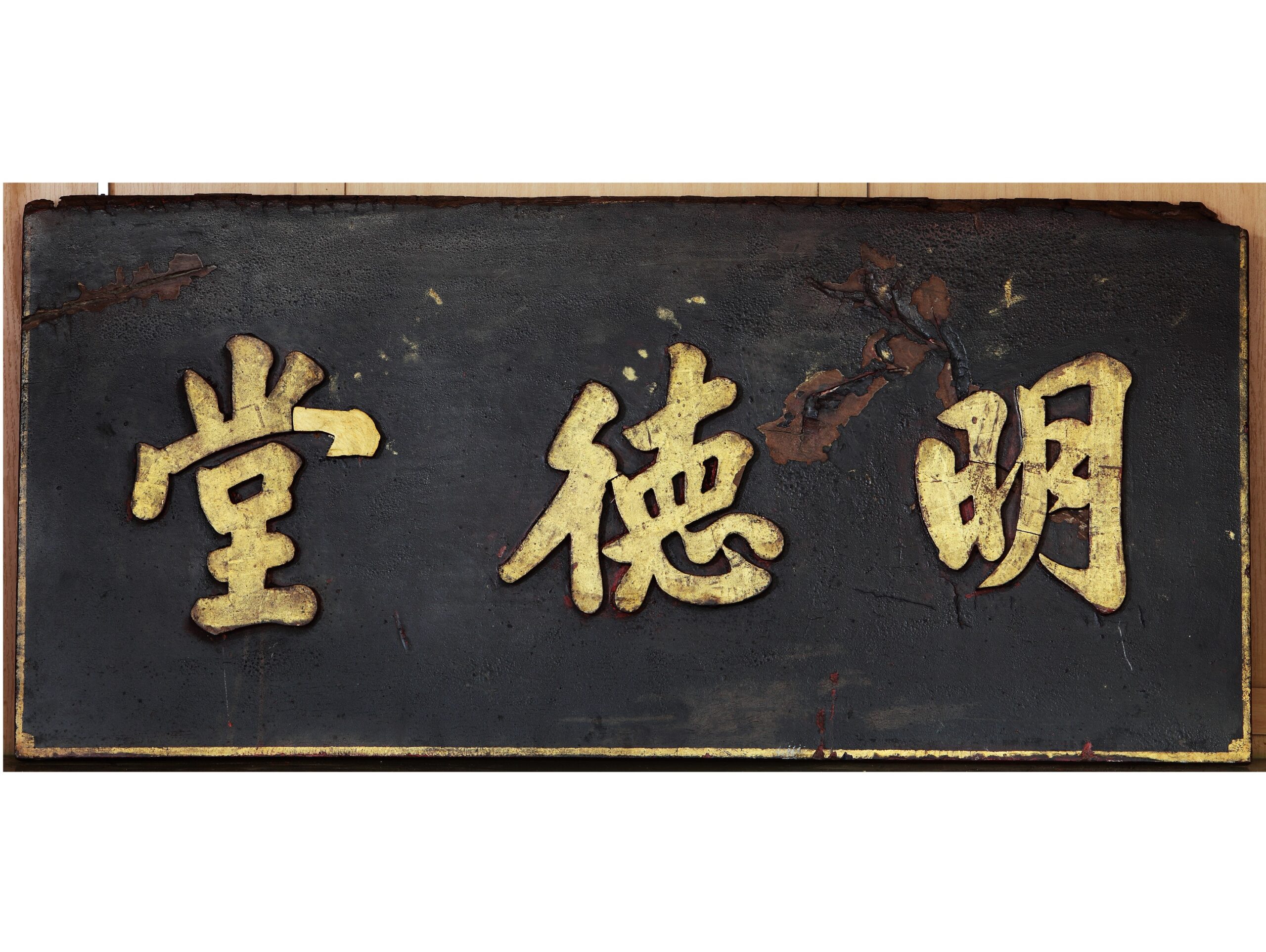
啟明堂剛成立時堂號匾額
The horizontal inscribed board of Chi Ming Hall
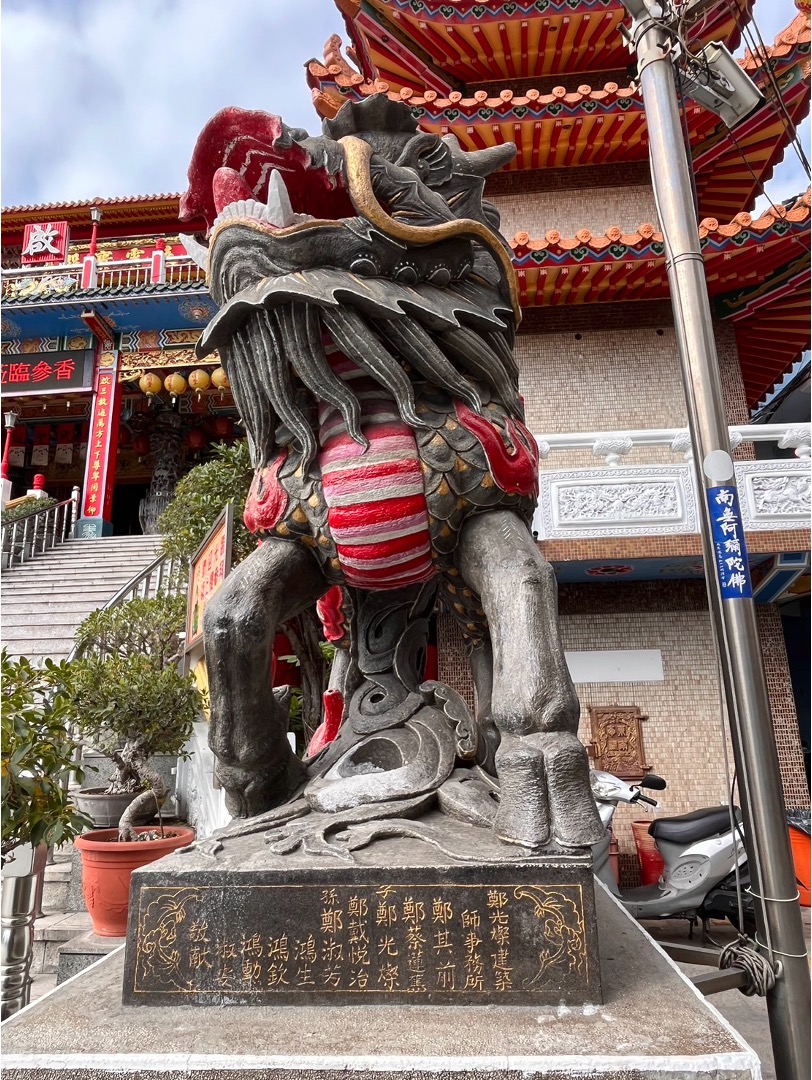
建築師參與啟明堂與慈濟宮興建工程並作供養
Architecture of Fuluan
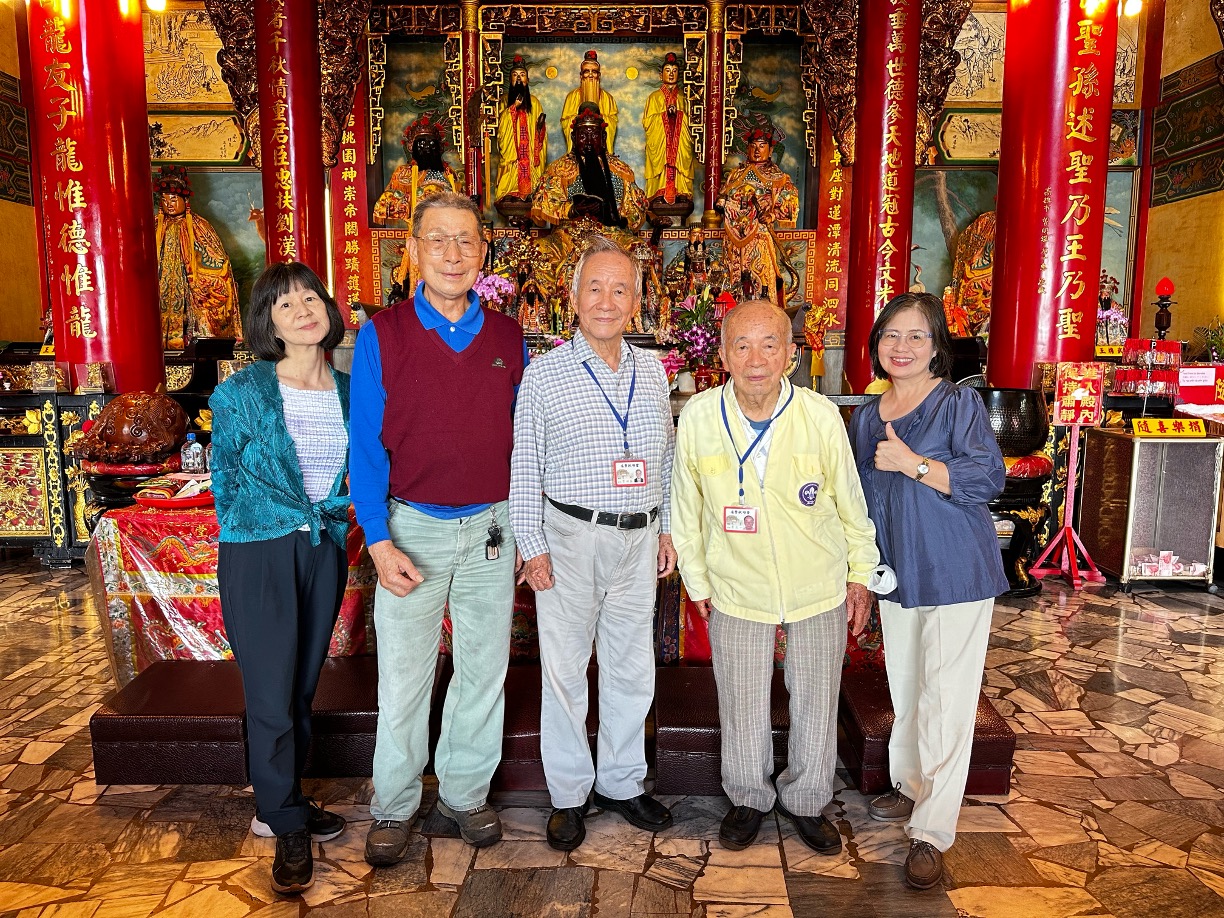
啟明堂合照 右一採訪者蔡碩玲 右二曾宏一文署 右三曾坤泰堂主 左二樂善社蔡松峻社長 左一採訪者蔡芳玲
Photo
